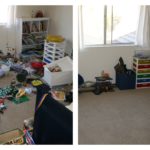5 Actions to Manage Kid’s Toys
Children come with many components from their diapers, changing tables, clothing to plush animals, toys, bigger toys and more toys. Often when I am working in smaller homes, the living room looks like a day care center because the parents have lost control of the toy situation and they, the toys, have successfully multiplied and overrun the home. Our homes should be homes and they need to look and operate as a home and not a kid’s playground. What to do?
First step: Control What Comes Into the Home. As the parents, you are the ones who say what comes in and what goes out. If you have the luxury of boundless space, then you have the options of having larger toys that can be contained in a garage, large playroom or back yard. If your home is small and space is of the essence, then you need to be highly judicious about what comes in. Of course, doting grandparents and friends want to give the little ones the best things with which to play. This may not always measure up to the needs you have established so your home doesn’t look like Romper Room. When space is short, then the toys need to match in scale to the home.
Step Two: Keep Toys Circulating. Toys have a shelf life. Many times kids play with toys for a certain time period and then are done. Parents who are having a second child will hold onto them so the next in line can play with them. Again, if space allows, this is fine. If space is limited, you will have to restrict what you keep for number 2 or 3 and let the rest go. Depending on your parenting style, some parents will remove the former toys while Jr. is out and donate without their knowing. Since it’s been out of sight and out of mind, this method can be effective for some parents. As kids get older, many of my clients will include the child in the decision making process so they can make the choice of what to eliminate. Most kids, I’ve found, are pretty good about letting go of toys they no longer need. On the other end, I get sentimental parents who just can’t part with baby’s first plushie or certain books and clothing due to the memories attached. Taking pictures of treasured items keeps the memory without the item.
Step Three: Have Designated Storage. Too often kid’s toys are overflowing in a living space with no way of containing them. Legos and Barbie accessories run wild as parents know all to well, stepping on sharp pieces with bare feet, and are often ready to throw them away. Having larger containers for balls and sports equipment as well for plush keeps these items from running amok. Smaller, like-pieces can be contained in clear bins and stacked. The toys can be played with and then returned to their respective bins. A low table works great for legos and puzzles than can be set up for longer use sessions.
Step Four: Keep Toys Corralled in Bedrooms/Playrooms. Too often kids want to play their games and toys where the family gathers such as living rooms and family rooms. That can be fine so long as you have a system in place where once play time is over, toys can be contained and returned to the bedroom or playroom. Otherwise, you get the daycare syndrome and your mutual living space is overrrun with toys. This can have an adverse effect on the family, especially when adults who work all day want and need a place of respite, can’t get when toys have taken over. Teach kids young to clean up after themselves and that will make parents’ work much easier.
Step Five: Kids want Electronics as soon as possible. Today’s children are incredibly tech savvy and can’t wait to get their hands on parent’s cell phones, tablets and the like. While it can be used to keep children quiet especially out in public, what I’ve seen is that once kids get their hands on these gadgets, that can often be their only choice with which to play. While this is a family/parental decision, keeping kids engaged using their imagination and creativity for as long as possible is a good thing. Electronic toys remove kids from playing outside, building, imagining and engaging with their minds. While keeping them off such devices, especially when they see their parents and friends on them, can be nearly impossible, having a healthy balance with toys is a good practice.
If you should need help managing your children’s toys, give me a call today at 510.501.1213 and let’s get your home organized and back in balance.

